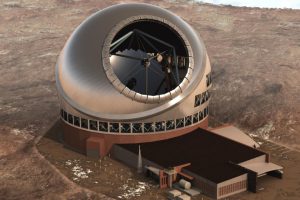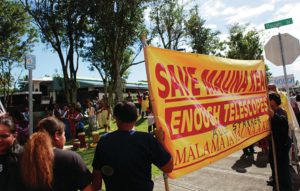Unlike the millions of tourists who visit Hawaii for vacation, astronomers hope to leverage the island’s clear skies (limited light pollution) and towering volcanoes to understand our solar system. Their preferred location is Mauna Kea, the highest summit in Hawaii extending 13,796 feet above sea level. But while astronomers see this dormant volcano as the perfect location for a telescope, the native people of Hawaii, Kanaka Maoli, view it as a sacred site for their people. Since 1968, 13 telescopes, collectively known as the Mauna Kea Observatories, have been built despite protest from the Kanaka Maoli. Astronomers from Cal Tech and around the world have proposed a new telescope called the Thirty Meter Telescope (TMT) to tower 18 stories above Mauna Kea, but the Kanaka Maoli have had enough. The TMT protests began on October 7th, 2014 when protesters disrupted the ground-breaking ceremony and gained national attention as people around the world began to debate about scientific research vs native tradition.
Mauana Kea is a sacred site for Kanaka Maoli tradition and plays an important role in their creation story. Per legend, the island chain of Hawaii was created by the sky father, Wakea, and the earth mother, Papahanaumoku. Mauna Kea is considered their first born and despite its sacred role in native tradition, the scientific community continues to deface it with telescopes, disregarding the culture behind it. While the site has been defaced by the previous 13 telescopes, the TMT will be the largest telescope by far.

When constructed, the $1.4 billion TMT will be world’s largest and strongest telescope standing 180 feet tall and a dome diameter of 217 feet. Equipped with a 30-meter primary mirror, the TMT is designed for optical and infrared observing and will help astronomers see 13 billion lightyears away. Compared to the Hubble Space Telescope, the TMT will have 144 times the collecting area and a better spatial resolution by a factor of 10. But despite the massive scientific upside to this telescope, its controversial location has sparked a legal battle and halted construction.
The Kanaka Maoli protesters have pursued legal action to preserve the sacred Moana Kea from the TMT. Protesters originally appealed the State Board of Law and Resources (SBLR) construction permit but was denied by a local circuit court. Unhappy with the decision, the protesters asked to bypass the Intermediate Court of Appeals and go directly to the Supreme Court. The Supreme Court agreed to hear the case and ruled in December 2015 that the TMT’s permit wasn’t valid because BLNR issued it without holding a contested court hearing. This violated native Hawaiians constitutional rights and the Supreme Court’s voiding the permit is a step in the right direction for honoring their cultural ties to the sacred Moana Kea. TMT began the process to obtain a BLNR permit again in October 2016 and are still in contested court hearings.

While the TMT would have been the premier telescope in the world, it is unfinished and engulfed in controversy because of its intended location on the sacred Moana Kea. The Kanaka Maoli have been successful in standing up for their rights and culture by legally voiding the TMT construction permits through the Supreme Court. Additionally, the TMT team announced an alternative location for the telescope in the Canary Islands, Spain. Although TMT still prefers Moana Kea as the primary location, announcing an alternative sends a powerful message to the Kanaka Maoli protesters that their message is being heard and their culture will not be silenced.
Works Cited:
- http://www.nbcnews.com/news/asian-america/hawaii-supreme-court-voids-telescope-construction-permit-n473236
- http://www.nbcnews.com/news/asian-america/canary-islands-selected-alternate-site-thirty-meter-telescope-n677001
- http://www.tmt.org/observatory
- http://www.nbcnews.com/news/asian-america/new-hearings-begin-embattled-proposed-telescope-mauna-kea-n625276
- http://hawaiitribune-herald.com/news/local-news/tmt-groundbreaking-disrupted
- http://www.mauna-a-wakea.info/maunakea/F2_whitemountain.html
Picture Links:
- http://s1.ibtimes.com/sites/www.ibtimes.com/files/styles/lg/public/2015/06/22/top-view-tmt-complex.jpg
- http://hawaiitribune-herald.com/sections/news/local-news/showdown-thirty-meter-telescope.html
Additional Readings:
- More information about the 13 telescopes in the Mauana Kea Observatories:
- How the TMT telescope with boost the local economy:

It’s always great to see legal precedents set by indigenous people fighting back against scientific colonisation, but unfortunate that these measures are so costly. Reading this, I was reminded of the fights against pipelines that have been happening in British Columbia, where I live, for years. Groups, primarily indigenous, have had to spend massive amounts of money to fight legal battles, just to have cases appealed time and time again. It’s unfortunate that conflicting epistemologies cause so much conflict, and require this level of time and energy to (debatably) reconcile in this political climate. How far will people go to put institutions like economy and science over values of people who have been dealing with colonisation for centuries.
I really enjoyed reading this, good points are made and its nice to see culture finds success against big companies winning power with money. This situation is a question of what is more important, past cultural heritage or the potential for progressive data exploration leading to future improvements. It is an ethical question between whether finding something unknown is worth having to disrespect and destroy land in order to accomplish. Although a stretch, it can be related to the European settlers when they thought by coming into North America that they had more right to take over because they could make it better in the future. They took someone’s property by justifying they had more potential to develop in the future which ended up doing more damage then good. European settlers should not have taken over just like astronomers should not build TMT on sacred volcano land. The settlers set a precedent that anyone thinking they could produce something better over road the need to respect cultural ownership. Astronomers have done the right thing by finding an alternative that doesn’t violate cultural heritage. As well as the native people of Hawaii, Kanaka Maoli, doing the right thing by honouring their culture and refusing a third party coming in and violating history that makes them who they are.